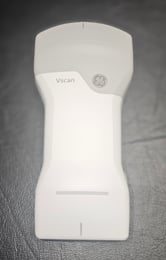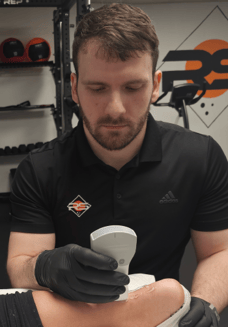Diagnostic Ultrasound
 By
Dr. Sam Zehnder
·
2 minute read
By
Dr. Sam Zehnder
·
2 minute read
At Rock Solid, we’re always looking beneath the surface—literally and figuratively—to help our patients recover faster and stay stronger. One of the most powerful tools we use to achieve this is diagnostic ultrasound.
You may associate ultrasound with prenatal care or cardiology, but in the hands of a skilled physical therapist, it becomes a dynamic, real-time imaging tool that helps diagnose injuries more accurately, track healing more effectively, and tailor treatments more precisely than ever before.
What Is Diagnostic Ultrasound?
 Diagnostic ultrasound, or musculoskeletal ultrasound (MSK-US), is a non-invasive imaging method that uses high-frequency sound waves to create live images of the body’s soft tissues—muscles, tendons, ligaments, joints, and nerves.
Diagnostic ultrasound, or musculoskeletal ultrasound (MSK-US), is a non-invasive imaging method that uses high-frequency sound waves to create live images of the body’s soft tissues—muscles, tendons, ligaments, joints, and nerves.
Unlike X-rays (which show bones) or MRIs (which offer static images), MSK ultrasound gives us a real-time, moving image of how your body is functioning. That means we can see what’s happening under the skin while you move—a huge advantage in diagnosing and treating movement-related pain and injuries.
Scientific Insight: According to a study by Melville, diagnostic ultrasound can achieve sensitivity and specificity comparable to MRI for a variety of types of tendon tears, subluxations, and degenerative changes (Melville et al, 2024.
How Does It Work?
At Rock Solid, we use a handheld device called a transducer, which emits sound waves into the body. These sound waves bounce off tissues and return to the transducer, creating an image on the screen. The clarity of the image helps us identify issues such as tendon inflammation, muscle tears, bursitis, nerve impingements, and more.
What makes ultrasound especially valuable is its dynamic nature—we can ask you to contract, stretch, or move a joint during the scan. This lets us see how the injury responds to motion or load, which static scans simply can't provide.
How Rock Solid Uses Diagnostic Ultrasound
At Rock Solid, we don’t rely on guesswork. Diagnostic ultrasound enhances our clinical assessments and interventions in several key ways:
-
Pinpointing the Injury: We use ultrasound to visualize tears, strains, or inflammation and distinguish between different tissues.
-
Guiding Interventions: Whether we’re performing dry needling, soft tissue mobilization, or neuromuscular re-education, ultrasound helps ensure we’re targeting the right structure at the right depth.
-
Tracking Healing: We use follow-up imaging to monitor tissue healing and adapt your plan of care as needed.
-
Patient Education & Biofeedback: You can see your muscles contracting on-screen, which helps you better understand and engage with your rehab.
Benefits to You, the Patient
Here’s why more and more Rock Solid patients are benefiting from diagnostic ultrasound:
✅ Immediate Results: No waiting weeks for imaging referrals—we scan and assess on the spot.
✅ Non-Invasive & Safe: No needles, no radiation, and completely pain-free.
✅ Cost-Effective: Significantly more affordable than MRI, without sacrificing accuracy for many conditions.
✅ Enhanced Precision: Your treatment is based on clear, visual data—not just symptom descriptions or manual testing.
✅ Motivational: Seeing your healing in real-time can be incredibly empowering.
Real Results, Real Recovery
At Rock Solid, our mission is simple: accurate diagnosis, effective treatment, faster recovery. Diagnostic ultrasound helps us deliver on all three.
Whether you’re struggling with shoulder pain, recovering from a sports injury, or dealing with chronic muscle tension, ultrasound gives us the ability to see what's really going on—and that helps us treat it smarter and faster.
If you're ready to see what’s beneath the surface and start building a rock-solid recovery plan, schedule an appointment today. Ask us how diagnostic ultrasound can help you get better—so you can get back to doing what you love.
References
-
Jacobson, J.A. (2017). Fundamentals of Musculoskeletal Ultrasound. Elsevier Health Sciences.
-
Melville DM, Taljanovic MS, Gimber LH, Miller M, Ahmad A, Sepich D, Latt LD. Comparison of Ultrasound and MRI with Intraoperative Findings in the Diagnosis of Peroneal Tendinopathy, Tears, and Subluxation. J Clin Med. 2024 Jan 27;13(3):740. doi: 10.3390/jcm13030740. PMID: 38337434; PMCID: PMC10856550.